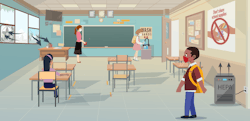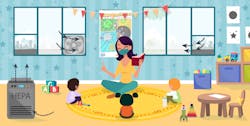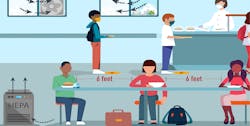CDC Issues New Recommendations for School Ventilation
PRESS RELEASE
ATLANTA, GA, FEBRUARY 26, 2021 -- Ventilation is one component of maintaining healthy environments, and is an important COVID-19 prevention strategy for schools and childcare programs. Wearing a well-fitting, multi-layer mask helps prevent virus particles from entering the air or being breathed in by the person wearing a mask. Good ventilation is another step that can reduce the number of virus particles in the air. Along with other preventive actions, ventilation can reduce the likelihood of spreading disease. Below are ways you can improve ventilation in your school or childcare program, whether in a large building or in a home:
BRING IN AS MUCH OUTDOOR AIR AS POSSIBLE
- If safe to do so, open windows and doors. Even just cracking open a window or door helps increase outdoor airflow, which helps reduce the potential concentration of virus particles in the air. If it gets too cold or hot, adjust the thermostat. Do not open windows or doors if doing so poses a safety or health risk (such as falling, exposure to extreme temperatures, or triggering asthma symptoms).;
- Use child-safe fans to increase the effectiveness of open windows. Safely secure fans in a window to blow potentially contaminated air out and pull new air in through other open windows and doors;
- Consider having activities, classes, or lunches outdoors when circumstances allow.
ENSURE HVAC SETTINGS ARE MAXIMIZING VENTILATION
- Make sure your ventilation systems are serviced and meeting code requirements. They should provide acceptable indoor air quality, as defined by ASHRAE Standard 62.1external icon, for the current occupancy level for each space.* Home-based childcare programs should meet requirements established by their state and local regulatory authorities;
- Set HVAC systems to bring in as much outdoor air as your system will safely allow. Reduce or eliminate HVAC air recirculation, when practical and with expert HVAC consultation;*
- Increase the HVAC system’s total airflow supply to occupied spaces when you can. More air flow encourages air mixing and ensures any recirculated air passes through the filter more frequently;
- Disable demand-controlled ventilation (DCV) controls that reduce air supply based on occupancy or temperature. This way the air supply will remain constant throughout the day;
- For simple HVAC systems controlled by a thermostat, setting the fan control switch from “Auto” to “On” will ensure the HVAC system provides continuous air filtration and distribution;
- Consider running the HVAC system at maximum outside airflow for 2 hours before and after the building is occupied to refresh air before arrival and remove remaining particles at the end of the day.
FILTER AND/OR CLEAN THE AIR IN YOUR SCHOOL OR CHILDCARE PROGRAM
- Improve the level of air filtration as much as possible without significantly reducing airflow;
- Make sure the filters are sized, installed, and replaced according to manufacturer’s instructions;
- Consider portable air cleaners that use high-efficiency particulate air (HEPA) filters to enhance air cleaning wherever possible, especially in higher-risk areas such as a nurse’s office or sick/isolation room;
- Consider using ultraviolet germicidal irradiation (UVGI) in schools and non-home-based childcare programs as a supplemental treatment to inactivate the virus that causes COVID-19, especially if options for increasing ventilation and filtration are limited. Consult a qualified professional to help design and install any UVGI system.
Opening vehicle windows even a little bit can improve ventilation.
USE EXHAUST FANS IN RESTROOMS AND KITCHENS
- Inspect and maintain exhaust ventilation systems in restrooms and kitchens;
- Ensure restroom and kitchen exhaust fans are on and operating at full capacity while the school or childcare program is occupied and for 2 hours afterward.
OPEN WINDOWS IN TRANSPORTATION VEHICLES
- Ventilation is important on buses and vans servicing schools and childcare programs, along with other strategies such as mask use for people over 2 years old and physical distancing;
- Keep vehicle windows open when it does not create a safety or health hazard. Having more windows open is more helpful, but even just cracking a few windows open is better than keeping all windows closed.
Resources for School and Childcare Administrators
- CDC: K-12 Schools COVID-19 Mitigation Toolkitpdf icon
- CDC: Operating Childcare Programs
- CDC: Ventilation in Buildings
- CDC: Improving Ventilation in your Home
- U.S. Environmental Protection Agency: Indoor Air Quality Tools for Schoolsexternal icon
- U.S. Environmental Protection Agency: Creating Healthy Indoor Air Quality in Schoolsexternal icon
- U.S. Department of Education: Strategies for Safely Reopening Elementary and Secondary Schoolspdf iconexternal icon
- Harvard University: 5 Step Guide to Checking Ventilation Rates in Classrooms external icon
- CDC: Schools and Childcare Programs: Plan, Prepare, and Respond
- National Resource Center for Health and Safety in Childcare and Early Education: Caring For Our Children Chapter 5.2.1: Ventilation, Heating, Cooling, and Hot Waterexternal icon
*If your district, school, or childcare program needs more ventilation support, select an HVAC professional with knowledge of ASHRAE standardsexternal icon to inspect and repair HVAC systems in schools. Your state or local jurisdiction may also regulate HVAC system settings and maintenance.


